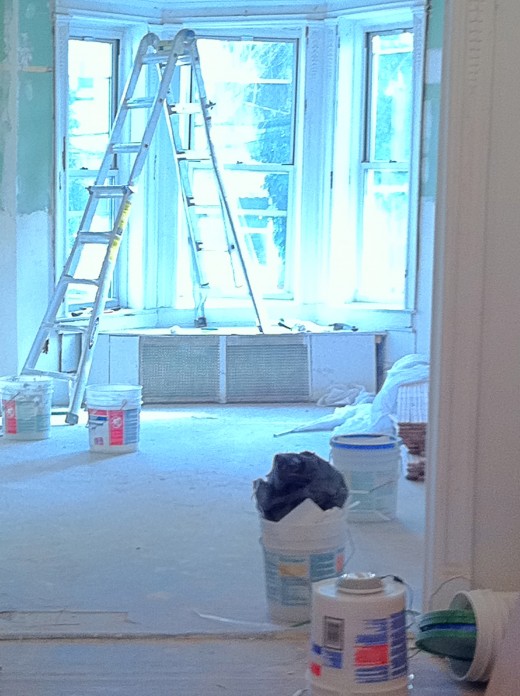How to Renovate a Townhouse in Brooklyn Volume 1 Edition 10
Anticipation

When Hubbie and I first started renovating our 112-year old townhouse in Brooklyn, our General Contractor expressed his calm confidence that we would be ready to move in within three months, four months tops, he said. Well, six months after the closing, the house had turned 113 years old and we had neither finished nor moved in.
Anticipation, like stress or love, is one of those feelings that you cannot anticipate or fabricate. It has a smooth and subtle quality that invades your emotional space when you either day-dreaming or working hard to make those dreams come true. Remember being a kid and waiting those excruciating eight weeks between Halloween and Christmas? It’s a lot like that.
Except in this case it comes along with paying the price to carry two mortgages in New York City at the same time.
All of this is to say, we are so close it actually hurts a little bit.


With all of the major systems in the house up and running, it is now a question of filling the hundreds of holes that that have been pounded into our big old house. It is a protracted but necessary labor that will make the place whole again so that the floors and fixtures can go in.
The work of filling, spackling, taping, sanding and priming all of the walls and ceilings of a 2,400 square foot living space (we left the basement raw) cannot be underestimated. To complicate the job, our ceilings soar at a gaping 12-foot height and the reams of ancient decorative trim on the walls and windows only add to the time-consuming effort. Finally, each layer of compound or plaster takes hours and hours to dry and must be sanded and re-applied if the first pass didn't get the job done.
From the point of view of experience, this phase of the project is of the opposite of the demolition. During the demo stage, progress is easily visible and swift gratification leads one to believe that there is a fast–track to renovation. Sheet rocking, taping and spackeling on the other hand, just take elbow grease, buckets of chemical-laden materials, the proper safety equipment, and lots and lots of time. Also, the acquisition of items like tubs and sinks has to be timed to perfection- no one wants their job held up because they sat around for three weeks waiting for the tile to arrive.




Meanwhile, Hubbie and I continued on our endless shopping expedition.
Just when we thought that we had made all of our purchasing choices, down to the last ceiling light can, we discovered that the plumber 's men had removed an entire wall of 100-year old tile from the bathroom upstairs.
Amazingly enough, there is a store in Harlem that sells the exact same subway tile that was removed from our Brooklyn upstairs bath. The Demolition Depot, on 125th Street ,is a sturdy and surreal 7-floor structure with two conjoined backyards. It houses an inventory of salvaged goods so vast and so spectacular, that it actually has the quality of being something out of a dream or urban myth.
In some inside-out way, Demolition Depot is little bit like a Home Depot, but with salvaged goods instead of new ones for the intrepid homeowner. It contains enough variety and inventory of materials to build an entire house- from wood doors to marble toilets, from wrought iron gates to eight-foot pillars, from claw foot tubs to limestone statuary. So, it made complete sense that they had the exact subway tiles we needed for our upstairs bath.




However, at $6 a piece it would have cost about $5,000 to replace the tiles that had been removed from our bathroom. This was where our surreal fantasy very quickly met the limits of financial reality and we found ourselves going back to the GC to propose another solution.
On one of the day's that Hubbie was assembling kitchen cabinets, he proposed to Sal that we would find a less expensive replacement tile for the upstairs bath if the GC would purchase and install it at no cost. Having agreed on the terms, Hubbie and I found a classic looking carrarra subway tile that complements the floors and upholds the old-world, institutional flavor of the subway tiles, while still looking elegant and urban. We were happy with the outcome and even more excited when our matching pedestal sinks went in.
After a brief episode of worry, calm had been restored to our project. We were moving forward without any unanticipated expenses and, once the holes had been closed up, the installation of the fixtures and appliciances started to move along almost as quickly as the demo.



It was really starting to look like we were going to be able to move in any day now.

Volume 1, Edition 11
- How To Renovate a Townhouse in Brooklyn Volume 1 Edition 11
Six months ago, Hubbie and I moved into our townhouse in Brooklyn. From the day we first walked into the dilapidated 113-year old house to the day we officially moved in, it has been a dynamic journey complete with bank lawyers, tile layers,...






